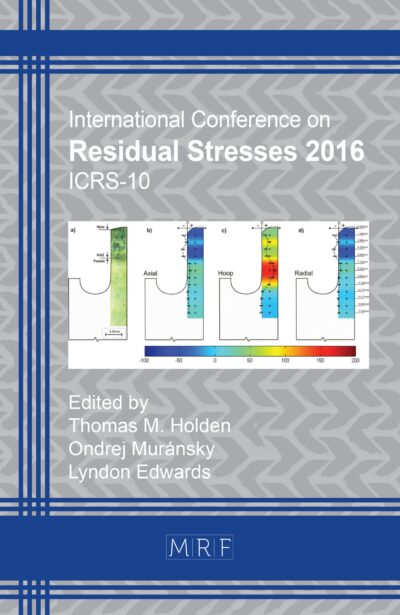Distinguishing Effect of Buffing Operation on Surface Residual Stress Distribution and Susceptibility of 304L SS and 321 SS Welds to Chloride Induced SCC
P.S. Kumar, K. Mankari, S.G. Acharyya
download PDFAbstract. Stress corrosion cracking (SCC) of austenitic stainless steels (ASS) and its weldments in presence of chloride ions is a key concern in its successful application. AISI 304L SS in surface milled, turned, ground conditions have high tensile residual stresses on the surface which lead to early cracking in an aggressive environment. Spot welds of AISI 321 SS have shown multiple failures due to chloride induced SCC as a result of high magnitude of tensile residual stresses and improper post weld heat treatment. The present study proposes a simple surface engineering method to prevent the initiation of stress corrosion cracking in austenitic stainless steel and its welds in presence of chloride ions. 304L SS in milled, turned and ground conditions and 321 SS in spot welded condition was subjected to surface buffing operation. Surface roughness was calculated using a surface profilometer and residual stresses were determined. Residual stress distribution, and phase transformation were calculated using X-ray diffraction measurements. The detailed microstructural characterization was performed using field emission scanning electron microscopy (FESEM). 304L plates and 321 SS welds in buffed and un-buffed conditions were tested for SCC susceptibility by exposing these to boiling MgCl2 as per ASTM G36. Results showed that 304L SS and 321 SS were resistant to SCC in buffed conditions as no cracking occured even after prolnged exposure to boiling MgCl2. Buffing being a very simple, economic and portable operation can be easily applied on large components of AISI 304L SS after the conventional surface finishing operations and AISI 321 SS weld also can be extended to components in service in an aggressive environment.
Keywords
Residual Stresses, Austenitic Stainless Steels, Stress Corrosion Cracking
Published online 9/11/2018, 6 pages
Copyright © 2018 by the author(s)
Published under license by Materials Research Forum LLC., Millersville PA, USA
Citation: P.S. Kumar, K. Mankari, S.G. Acharyya, ‘Distinguishing Effect of Buffing Operation on Surface Residual Stress Distribution and Susceptibility of 304L SS and 321 SS Welds to Chloride Induced SCC’, Materials Research Proceedings, Vol. 6, pp 139-144, 2018
DOI: https://dx.doi.org/10.21741/9781945291890-22
The article was published as article 22 of the book Residual Stresses 2018
![]() Content from this work may be used under the terms of the Creative Commons Attribution 3.0 licence. Any further distribution of this work must maintain attribution to the author(s) and the title of the work, journal citation and DOI.
Content from this work may be used under the terms of the Creative Commons Attribution 3.0 licence. Any further distribution of this work must maintain attribution to the author(s) and the title of the work, journal citation and DOI.
References
[1] N. Zhou, R. Pettersson, R. Lin Peng, M. Schönning, Effect of surface grinding on chloride induced SCC of 304L, Mater. Sci. Eng. A, 658 (2016) 50-59. https://doi.org/10.1016/j.msea.2016.01.078
[2] J.Ł.S. Topolska, M. Głowacka, Failure of austenitic stainless steel tubes during steam generator operation, J. Achiev. Mater. Manuf. Eng. 55 (2012) 378–385.
[3] S. Ghosh, V. Kain, Microstructural changes in AISI 304L stainless steel due to surface machining: Effect on its susceptibility to chloride stress corrosion cracking, J. Nucl. Mater., 403 (2010) 62-67. https://doi.org/10.1016/j.jnucmat.2010.05.028
[4] Pandu Sunil Kumar, Swati Ghosh Acharyya, S.V. Ramana Rao, Komal Kapoor, Surface buffing and its effect on chloride induced SCC of 304L austenitic stainless steel, 2018 IOP Conf. Ser.: Mater. Sci. Eng. 314 012002, doi:10.1088/1757899X/314/1/012002.
[5] H.B. P. Withers, Residual stress. Part 1 – measurement techniques., Mater. Sci. Tech., 17 (2001) 355-365. https://doi.org/10.1179/026708301101509980
[6] ASTM G-36, Standard Practice for Evaluating Stress-Corrosion-Cracking Resistance of Metals and Alloys in a Boiling Magnesium Chloride Solution, 2006, Reapproved
[7] S. Ghosh, V. Kain, Effect of surface machining and cold working on the ambient temperature chloride stress corrosion cracking susceptibility of AISI 304L stainless steel, Mater. Sci. Eng. A 527 (3) (2010) 679–683. https://doi.org/10.1016/j.msea.2009.08.039
[8] S. Ghosh, V.P.S. Rana, V. Kain, V. Mittal, S.K. Baveja, Role of residual stresses induced by industrial fabrication on stress corrosion cracking susceptibility of austenitic stainless steel, Mater. Des. 32 (7) (2011) 3823–3831. https://doi.org/10.1016/j.matdes.2011.03.012













